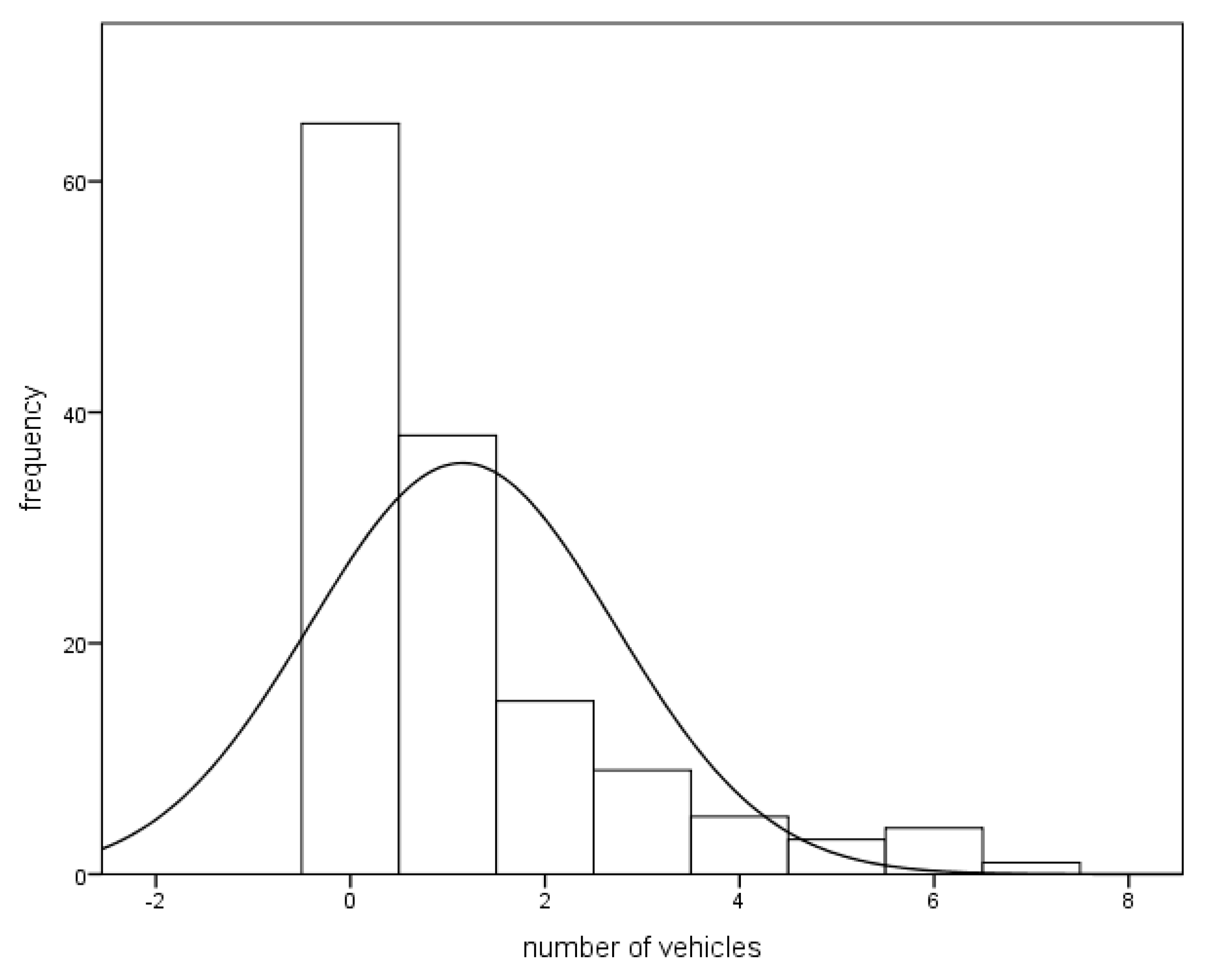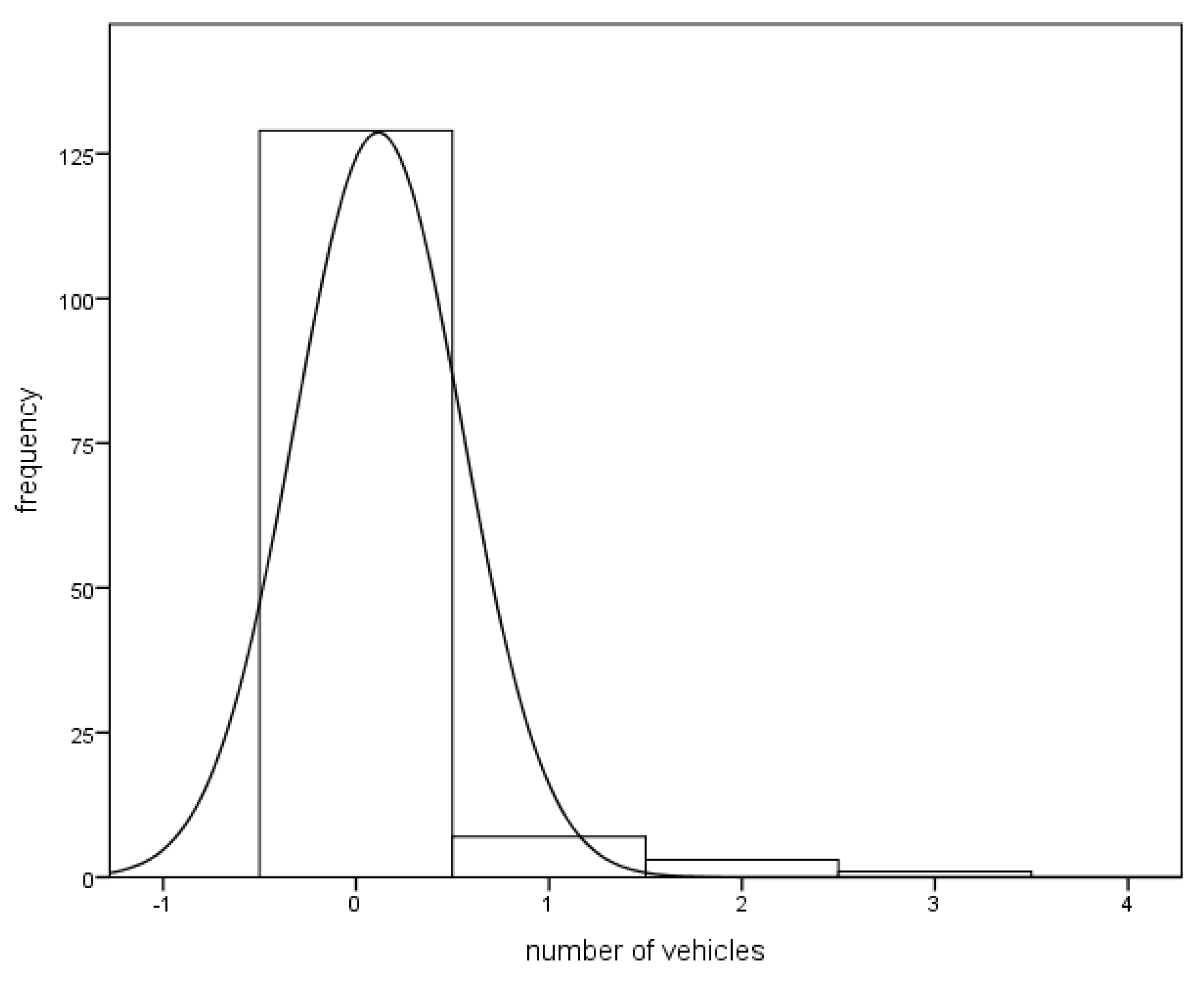The Impact of Pedestrian Crossing Flags on Driver Yielding Behavior in Las Vegas, NV
Abstract
1. Introduction
2. Materials and Methods
3. Results
3.1. Number of Vehicles that Passed in the Nearest Lane without Yielding while the Pedestrian Waited at the Curb Ready to Enter the Roadway
3.2. Number of Vehicles that Passed through the Crosswalk while the Pedestrian Was in the Same Half of the Roadway
4. Discussion
5. Conclusions
Author Contributions
Funding
Acknowledgments
Conflicts of Interest
References
- Friedman, L.F. Here Are the States Where the Most People Bike or Walk to Work. Business Insider-Science Web Site. Available online: https://www.businessinsider.com/here-are-the-states-where-the-most-people-walk-or-bike-to-work-2014-7. (accessed on 1 July 2019).
- Pooley, C.G. Promoting Walking and Cycling: New Perspectives on Sustainable Travel; Policy Press: Bristol, England, 2013. [Google Scholar]
- National Safety Council Tabulations of NHTSA Fatality Analysis Reporting System Data and National Center for Statistics and Analysis; (2018, March-Revised). Pedestrians: 2016 data. (Traffic Safety Facts. Report No. DOT HS 812 493); NHTSA: Washington, DC, USA, 2013.
- United States Environmental Protection Agency. EnviroAtlas. Percent of Workers Who Bike or Walk to Work 2016. Retrieved: 19 July 2019. Available online: https://enviroatlas.epa.gov/enviroatlas/DataFactSheets/pdf/Supplemental/Percentofworkerswhobikeorwalktowork.pdf (accessed on 19 July 2019).
- Centers for Disease Control and Prevention. Facts About Physical Activity 2014. Retrieved: 2 April 2018. Available online: https://www.cdc.gov/physicalactivity/data/facts.htm (accessed on 2 April 2018).
- Coughenour, C.; Clark, S.; Singh, A.; Claw, E.; Abelar, J.; Huebner, J. Examining racial bias as a potential factor in pedestrian crashes. Accid. Anal. Prev. 2017, 98, 96–100. [Google Scholar] [CrossRef] [PubMed]
- Sun, D.; Ukkusuri, S.V.S.K.; Benekohal, R.F.; Waller, S.T. Modeling of Motorist Pedestrian interaction at uncontrolled mid-block crosswalks. In Proceedings of the 82nd TRB Annual Meeting, Transportation Research Board, Washington, DC, USA, 12–16 January 2003. [Google Scholar]
- Schroeder, B.J.; Rouphail, N.M. Event-based modeling of driver yielding behavior at unsignalized crosswalks. J. Transp. Eng. 2010, 137, 455–465. [Google Scholar] [CrossRef]
- Zhang, Y.; Williams, B. Distracted driving. JAMA 2015, 314, 1768. [Google Scholar] [CrossRef] [PubMed][Green Version]
- Horrey, W.; Lesch, M.; Melton, D. Distracted driving. Prof. Saf. 2010, 55, 34–39. [Google Scholar]
- Asimakopoulos, S.; Asimakopoulos, G.; Spillers, F. Motivation and user engagement in fitness tracking: Heuristics for mobile healthcare wearables. Informatics 2016, 4, 5. [Google Scholar] [CrossRef]
- Harrison, D.; Marshall, P.; Bianchi-Berthouze, N.; Bird, J. Activity tracking: Barriers, workarounds and customization. In Proceedings of the 2015 ACM International Joint Conference on Pervasive and Ubiquitous Computing, Osaka, Japan, 7–11 September 2015. [Google Scholar]
- Gouveia, R.; Karapanos, E.; Hassenzahl, M. How do we engage with activity trackers? A longitudinal study of Habito. In Proceedings of the 2015 ACM International Joint Conference on Pervasive and Ubiquitous Computing, Osaka, Japan, 7–11 September 2015. [Google Scholar]
- Smith, K. In the driver’s seat: TrueMotion app tracks distracted driving behaviors to educate people behind the wheel. Best Rev. 2017, 117, 45. [Google Scholar]
- Trueman, R. Bluetooth device ends distracted driving. Des. News 2014, 69, 28. [Google Scholar]
- Barin, E.N.; McLaughlin, C.M.; Farag, M.W.; Jensen, A.R.; Upperman, J.S.; Arbogast, H. Heads up, phones down: A pedestrian safety intervention on distracted crosswalk behavior. J. Community Health 2018, 43, 810–815. [Google Scholar] [CrossRef] [PubMed]
- Van Houten, R.; Malenfant, J.E.; Blomberg, R.D.; Huitema, B.E. The Effect of High-Visibility Enforcement on Driver Compliance with Pedestrian Right-of-Way Laws: Four-Year Follow-up; (No. DOT HS 812 364); National Highway Traffic Safety Administration: Washington, DC, USA, 2017.
- Schwebel, D.; Barton, B.; Shen, J.; Wells, H.; Gobar, A.; Heath, G.; McCullough, D. Systematic review and meta-analysis of behavioral interventions to improve childe pedestrian safety. J. Pediatr. Psychol. 2014, 39, 826–845. [Google Scholar] [CrossRef] [PubMed]
- Retting, R.A.; Ferguson, S.A.; McCartt, A.T. A review of evidence-based traffic engineering measures designed to reduce pedestrian—Motor vehicle crashes. Am. J. Public Health 2003, 93, 1456–1463. [Google Scholar] [CrossRef] [PubMed]
- Turner, S.; Fitzpatrick, K.; Brewer, M.; Park, E.S. Motorist yielding to pedestrians at unsignalized intersections: Findings from a national study on improving pedestrian safety. Transp. Res. Rec. 2016, 1982, 1–12. [Google Scholar] [CrossRef]
- The League of American Bicyclists. 2018 Benchmarking Report. Available online: https://bikeleague.org/benchmarking-report (accessed on 1 July 2019).
- Mackenzie, R. Flags Help with Crosswalk Safety; The Chronicle Herald: Halifax, NS, Canada, 2017; p. 3. [Google Scholar]
- Simpson, P. Crosswalk Flag Thefts Tagged; The Chronicle Herald: Halifax, NS, Canada, 2016; p. 26. [Google Scholar]
- City of Berkley (n.d.). Pedestrian Flag Program in Berkley. Available online: https://www.cityofberkeley.info/ContentDisplay.aspx?id=14286 (accessed on 1 July 2019).
- Smart Growth America. National Complete Streets Coalition, 2019; Dangerous by Design 201 (date accessed 07.30.19); Smart Growth America: Washington, DC, USA, 2019. [Google Scholar]
- Pharr, J.; Coughenour, C.; Bungum, T. Environmental, human and socioeconomic characteristics of pedestrian injury and death in Las Vegas, NV. Int. J. Sci. 2013, 2, 9. [Google Scholar]
- Ewing, R.; Hamidi, S. Urban sprawl as a risk factor in motor vehicle occupant and pedestrian fatalities: Update and refinement. Transp. Res. Rec. 2015, 2513, 40–47. [Google Scholar] [CrossRef]
- Nevada State Legislature, Nevada Revised Statutes NRS 484B.283. Right-of-Way in Crosswalk; Impeding Ability of Driver to Yield Prohibited; Overtaking Vehicle at Crosswalk; Obedience to Signals and other Devices for Control of Traffic; Additional Penalty if Driver is Proximate Cause of Collision with Pedestrian; Chapter 484 B Rules of the Road; Nevada State Legislature: Carson, NV, USA, 1969.
- Nevada State Legislature, Nevada Revised Statutes NRS 484B.280. Duties of Driver of Motor Vehicle to Pedestrian; Additional Penalty if Driver is Proximate Cause of Collision with Pedestrian; Chapter 484 B Rules of the Road; Nevada State Legislature: Carson, NV, USA, 1969.
- Mehta, M.; Gupta, R. LBP-Haar Cascade Based Real-Time Pedestrian Protection System Using Raspberry Pi. In Communications in Computer and Information Science, Proceedings of the International Conference on Recent Trends in Image Processing and Pattern Recognition, Solapur, India, 21–22 December 2018; Springer: Singapore, 2018; pp. 60–73. [Google Scholar]
- Young, K.; Salmon, P. Sharing the responsibility for driver distraction across road transport systems: a systems approach to the management of distracted driving. Accid. Anal. Prev. 2015, 74, 350–359. [Google Scholar] [CrossRef]



| df | Mean Square | F | p-Value | Partial Eta Squared | |
|---|---|---|---|---|---|
| Corrected model | 3 | 4.600 | 2.200 | 0.088 | 0.023 |
| Intercept | 1 | 373.333 | 178.566 | <0.001 | 0.393 |
| PCF | 1 | 12.876 | 6.159 | 0.014 | 0.022 |
| Street location | 1 | 0.011 | 0.005 | 0.943 | 0.000 |
| PCF * street interaction | 1 | 0.868 | 0.415 | 0.520 | 0.002 |
| Error | 276 | 2.091 | |||
| Total | 280 |
| df | Mean Square | F | p-Value | Partial Eta Squared | |
|---|---|---|---|---|---|
| Corrected Model | 3 | 0.674 | 4.128 | 0.007 | 0.043 |
| Intercept | 1 | 4.503 | 27.563 | <0.001 | 0.091 |
| PCF | 1 | 1.417 | 8.674 | 0.004 | 0.030 |
| Street location | 1 | 0.003 | 0.016 | 0.898 | 0.000 |
| PCF * street interaction | 1 | 0.603 | 3.689 | 0.056 | 0.013 |
| Error | 276 | 0.163 | |||
| Total | 280 |
© 2019 by the authors. Licensee MDPI, Basel, Switzerland. This article is an open access article distributed under the terms and conditions of the Creative Commons Attribution (CC BY) license (http://creativecommons.org/licenses/by/4.0/).
Share and Cite
Clark, S.; Coughenour, C.; Bumgarner, K.; de la Fuente-Mella, H.; Reynolds, C.; Abelar, J. The Impact of Pedestrian Crossing Flags on Driver Yielding Behavior in Las Vegas, NV. Sustainability 2019, 11, 4741. https://doi.org/10.3390/su11174741
Clark S, Coughenour C, Bumgarner K, de la Fuente-Mella H, Reynolds C, Abelar J. The Impact of Pedestrian Crossing Flags on Driver Yielding Behavior in Las Vegas, NV. Sustainability. 2019; 11(17):4741. https://doi.org/10.3390/su11174741
Chicago/Turabian StyleClark, Sheila, Courtney Coughenour, Kelly Bumgarner, Hanns de la Fuente-Mella, Chantel Reynolds, and James Abelar. 2019. "The Impact of Pedestrian Crossing Flags on Driver Yielding Behavior in Las Vegas, NV" Sustainability 11, no. 17: 4741. https://doi.org/10.3390/su11174741
APA StyleClark, S., Coughenour, C., Bumgarner, K., de la Fuente-Mella, H., Reynolds, C., & Abelar, J. (2019). The Impact of Pedestrian Crossing Flags on Driver Yielding Behavior in Las Vegas, NV. Sustainability, 11(17), 4741. https://doi.org/10.3390/su11174741






